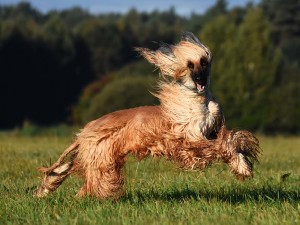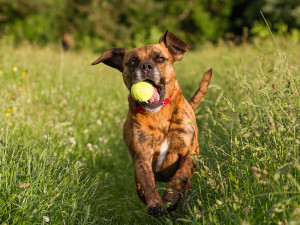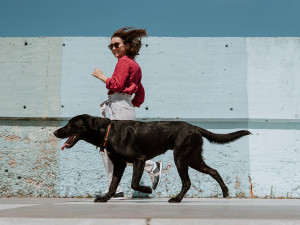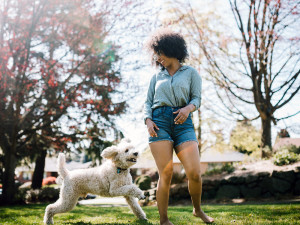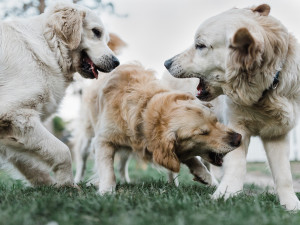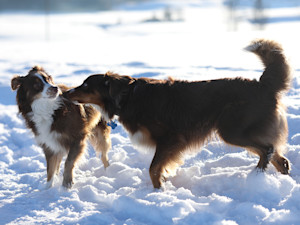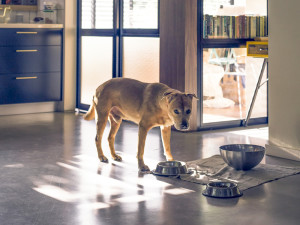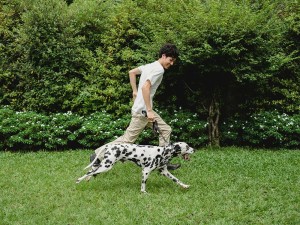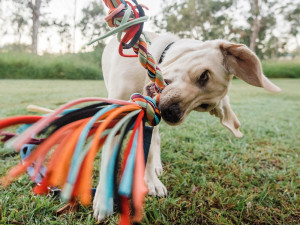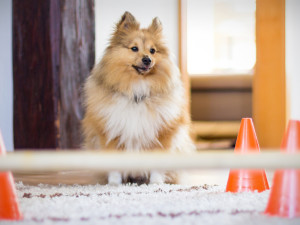Play-Training Can Be Your Solution to Dog Aggression
Behavior correction, Mary Poppins style: Turn a job into a game.
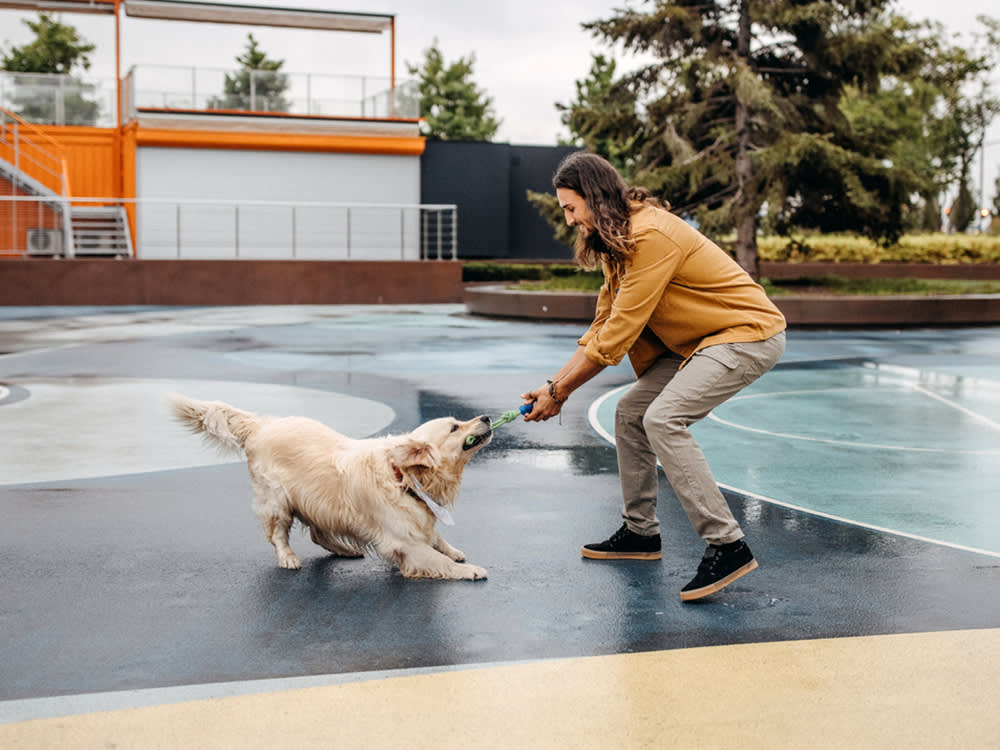
Share Article
A Corgi who barks, spins, leaps, and sometimes bites when anyone in her house stands up or moves around. A German Shepherd / Husky cross who barks, lunges, and charges at dogs walking by her house. A Poodle who growls at other dogs when on leash. A mixed breed who is terrified of visitors and barks at them nonstop. A Papillon puppy who bites his elderly Labrador Retriever housemate when the older dog doesn’t want to play with him. What do these aggressive dogs have in common? All of them had their behavior improved through the use of play.
How Play-Training Helps with Aggression in Dogs
Years ago, I began to regularly incorporate play into programs for aggressive dogs. Play is a powerful tool when working with aggressive dogs who are misbehaving because of frustration, arousal, lack of impulse control, boredom, or fear. Play has a positive effect on emotions, which is why play-motivated fearful dogs often respond better to play than to treats, even if they are also highly treat-motivated — fear decreases faster and more thoroughly in response to the former than to the latter. There are many different ways that play can help aggressive dogs to behave better.
How It Works:
Theoretically, you can stop a dog’s unwanted behavior by teaching them something incompatible with that behavior — for example, you can counteract a dog’s habit of jumping on people by teaching them to sit in the presence of others. But when a dog struggles with high arousal (many aggressive dogs do), you’re more likely to have success by teaching the dog to perform an active behavior. Trying to teach a dog to lie down, stay, or another static, controlled behavior is more challenging and generally less effective.
Fetch
Once, I worked with a Corgi who was aggressive when people moved around, and the more aroused she was, the more reactive and out of control she became. My goal was to transfer that energy using her favorite game, fetch. Now, when people are active, she brings a ball to her people, who then play fetch with her. By itself, the act of getting a toy can have an inhibitory effect, but it’s even better to teach the dog to get a toy in order to initiate a game. The anticipation gave the Corgi a happy feeling: “Yay, somebody moved! That means playtime.”

The mixed breed, who was terrified of visitors, loved fetch and she warmed up fast to anyone who would play it with her. To take advantage of this, I used classical counterconditioning to change her emotional response to visitors. Specifically, I taught her to associate them with fetch; I wanted her to feel the same joy when guests arrived as she felt when playing fetch. So, everyone who entered her home threw a ball for her. Eventually, the appearance of a visitor became the cue that a game of fetch was about to happen. Instead of responding with fear because a stranger had entered, she now responds with enthusiasm.
Tug
The German Shepherd / Husky cross, who reacted to dogs passing by, was easily aroused and struggled with impulse control. Her pet parents, who had already tried calling her away and using treats to capture her attention, were convinced that she would never be able to focus on anything with another dog in sight. She was not just beyond their control but actually beyond her own control. However, she loved to play tug, and no matter how high her arousal was or what distractions were present, she was captivated by her tug rope.
This game was the perfect way to redirect her attention. Once she learned that when a dog came into view, she would be given an opportunity to play tug, she stopped going wild at the sight of a dog and instead, turned immediately and joyfully to her person for a play session. Tug helped her control herself.
Tug has many advantages when working with an aggressive dog, as long as tug does not incite the aggression. It not only keeps the dog near you and their mouth occupied, it also allows you to direct the dog’s line of sight, which can be especially useful if the dog is visually stimulated. Dogs who tug usually love to play the game, which makes it a compelling option.
Running
The Poodle who was reactive to other dogs when on leash is one of the most playful dogs I have ever known — and one of the smartest. His training was excellent, and he could perform many behaviors on cue, even in the presence of another dog. But if he saw the dog first, he would bark, lunge, and pull so hard on the leash that he had caused his person to fall more than once.
All of that changed when I started reinforcing him with play. If he controlled himself when he saw another dog — performing any behavior other than reacting — he was allowed to play. He was willing to work for play, but the play had to be the “right” kind: running after his person. Once this reinforcement system was established, when he saw another dog, he would look at her as if to say, “Well, don’t you have some running to do?” and then happily chase after her.
Toys and games
Frustration and boredom were the root causes in the case of the Papillon puppy who was aggressive to the Labrador Retriever. The older dog was interested in playing with the puppy for no more than two to three minutes at a time, but the puppy wanted to frolic morning, noon, and night. When the Lab called a halt, the puppy would growl, leap on the Lab and bite him, sometimes causing injuries.
It was essential to find other ways to engage the Papillon in play — ways that would provide him with enough fun, mental and physical exercise, and other stimulation to keep him happy. The first step was to determine which toys, games, and activities appealed to him. Never has my job been easier, because this dog loved everything. I imagined him thinking, Plush toys? I love them. They’re my favorite. Tug toys? I love them. They’re my favorite. Balls? I love them. They’re my favorite.
Every single thing I tried was a success — puzzle-toys, squeaky toys, bouncy toys, rope toys, balls, disks, Kongs. He liked them all. Discovering a variety of new games and either learning or inventing ways to play with different toys satisfied his intense need for play. He played fetch, tug, chase, and hide-and-seek with people. When people weren’t available, he learned to enjoy throwing objects in the air and catching them, puzzles of all sorts, dribbling a ball around like a soccer star, and rolling balls down ramps and then chasing after them. Between the variety of toys and the multiple “play stations” we set up around his house, he learned to entertain himself for long stretches at a time.
Once I showed his pet parents new ways to play with their puppy, they interacted with him much more, which took a lot of pressure off the older dog. Now, the Papillon plays appropriately and briefly with the Lab a few times a day, and when the Lab is done, the puppy chooses a different way to play. Providing additional options was essential in helping this puppy behave in an acceptable manner around the other dog in his family.
There are many ways to change aggressive behavior, and an important part of my work is deciding which one will work best for a particular dog. While play is not part of the solution for every dog, it can help many of them, and increasingly, I find that I can help people and their dogs succeed by incorporating play into their programs. Yes, play is fun, but when working with aggressive dogs, it can be so much more.

Karen B. London, PhD, CAAB, CPDT-KA
Karen B. London is a certified applied animal behaviorist (CAAB) and certified professional dog trainer (CPDT) who specializes in working with dogs with serious behavioral issues, including aggression. She has written for a variety of magazines including The Bark, Clean Run, and the APDT Chronicle of the Dog, and has published in scientific journals including Behavioral Ecology and Sociobiology, Ethology, Ecology, and Evolution, the Journal of Insect Behavior, and Insectes Sociaux. She is the author of seven books about dog training and canine behavior, including the forthcoming My Dog's Mystery Adventure: And Other Stories From a Canine Behaviorist and Dog Trainer.
Related articles
![Three golden retriever's playing in the grass.]()
How to Break Up a Dog Fight
Keep you and your dog safe in case of a dog fight emergency.
![Two Australian Shepherd dogs meeting in the snow]()
Are Your Dogs Arguing With Each Other?
How to tell the difference between dog aggression and communication.
![Dog in high contrast lit hallway standing near a food bowl]()
Your Pet’s Behavioral Issues Might Be All in Their Gut
It’s a gut thing: Your dog’s GI issues could be linked to their mental health.
![Man running with dalmatian dog on a leash in a backyard with grass]()
An Active Dog Is a Well-Behaved Dog
Why regular exercise can mean a less destructive dog and a happier you.
![Owner serving dog food]()
Your Dog’s Food Aggression Isn’t Cute — Here’s How You Can Work On It
No longer associate feeding time with growling time.
![A blonde woman wearing a black t-shirt and striped overalls playing tug with her tan dog using an orange basketball squeaky toy]()
Playing Tug With Your Dog Is Good Exercise For Both Of You
Basics of the tug game and how to troubleshoot common problems.
![A close up shot of a dog biting on a tug of war dog toy outside in a grassy lawn.]()
Tug-Of-War: How To Find the Right Tug Toy For Your Dog
It doesn’t have to be a battle.
![Shetland sheepdog sits in front of a obstacle course for dogs in the living room]()
3 Fun Indoor Games to Play With Your Dog This Winter
Bad weather? These activities will keep your dog (and you!) from going stir crazy.

